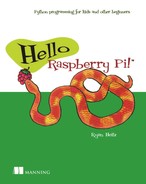List of Figures
Chapter 1. Meet Raspberry Pi
Chapter 2. Exploring Python
Figure 2.3. The menu at your favorite burger restaurant
Figure 2.4. Use the + symbol to add numbers in Python.
Figure 2.6. The menu at your pizza restaurant
Figure 2.19. Viewing the contents of folders using File Manager
Figure 2.20. Try using the print function and strings to make a screen full of 1s and 0s.
Chapter 3. Silly Sentence Generator 3000: creating interactive programs
Figure 3.2. An interactive game lets you put in information, and then it creates an output.
Figure 3.3. Select Menu-->Programming-->Python 3 to open the Python Shell on your Raspberry Pi.
Figure 3.8. Running the program SillySentence.py displays a welcome message on the screen.
Figure 3.14. The Silly Sentence Generator 3000 makes some absurd sentences based on words you enter.
Chapter 4. Norwegian Blue parrot game: adding logic to programs
Figure 4.4. Click the Python 3 icon to open IDLE’s Python 3 Shell on your Raspberry Pi.
Chapter 5. Raspi’s Cave Adventure
Figure 5.11. Highlighting by IDLE when there is only one equals sign
Chapter 6. Blinky Pi
Chapter 7. Light Up Guessing Game
Figure 7.4. Circuit diagram for the Light Up Guessing Game project
Chapter 8. DJ Raspi
Figure 8.8. The jumper connects power (3.3 volts) to the bottom of the button.
Figure 8.9. Add the resistor. Make sure its ends are pushed down into the breadboard holes.
Appendix A. Raspberry Pi troubleshooting
Appendix B. Raspberry Pi ports and legacy boards
Figure B.3. Enter the pre-shared key for the network and click OK to connect to it.
Appendix C. Solutions to chapter challenges
Figure C.1. Make the cat dance in Scratch by dragging program blocks into the script area.
